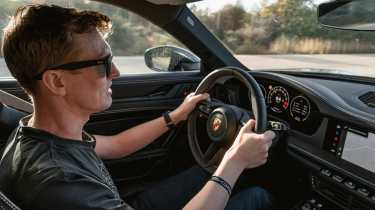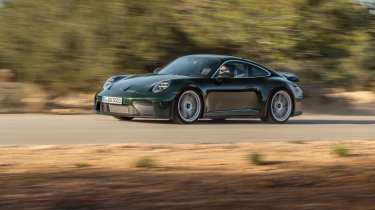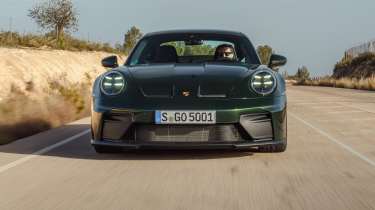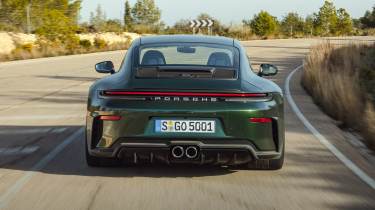Porsche 911 GT3 Touring (992.2) 2025 review – wingless 9000rpm special is better than ever
We’ve tested the new GT3 on track; now for the wingless Touring version, on the road
This is our first experience behind the wheel of the newly updated, 992.2 generation 2025 Porsche 911 GT3 Touring. From launch, it’s available in two body styles: the familiar, winged 911 GT3 form, and the more understated 911 GT3 Touring style, with its cleaner body and deleted rear spoiler.
Whichever body style you go for, and whichever gearbox option (both are available with either a six-speed H-pattern manual, or PDK twin-clutch paddleshift), the price is the same: £157,300 in the UK before options. And there are a few heartily priced options available…
> Electric Porsche Cayman and Boxster spied testing
At the international launch, we’ve driven the ‘regular’ GT3 on track – you can read the review here – and the GT3 Touring on the road. An overview of what’s new in the 992.2 GT3 as a whole is in the other review. This review, meanwhile, drops straight into the driving seat of the GT3 Touring. Or, to give it its official name, the ‘Porsche 911 GT3 with Touring Package.’
That seat in this case is the new, optional folding carbonfibre bucket seat. That’s because, for the first time, the GT3 Touring is available with rear seats – ruled out in the previous generation due to its fixed carbon buckets. Customer demand has led to the +2 option, available at no extra cost.
There’s also more customisation for the Touring than before. If they wish, buyers can spec it with the Lightweight (or Leichtbau) pack, a reassuringly/terrifyingly expensive £29,223 option bundle which includes forged magnesium wheels (as seen on 2023’s limited-run Porsche 911 S/T), carbonfibre for the roof, rear anti-roll bars and coupling rods, lightweight door panels (and the aforementioned folding carbon bucket seats, which can be specced separately for £5390; electric-adjust sports seats are otherwise standard equipment).
More reviews
The pack saves 22kg, and it’s the first time you can spec the Touring in this way. So you can either take the car in a more comfort-oriented direction, or with the lightweight package, toward a more road-racer-ish vibe. Porsche’s GT model line director Andreas Preuninger describes this spec as a sharper than ever Touring, ‘maybe a little s/t with no capitals.’
The Touring we’re driving here has the Lightweight pack, and six-speed manual gearbox (which, as part of the pack, swaps its regular gearlever for the shorter handle from the 911 S/T, for a snappier-still shift action). The gearchange is easier to get to grips with than that of the S/T, with its tiny clutch and flyweight flywheel, but demands concentration nonetheless. You can’t dawdle – it rewards positive, well-timed shifts. No bad thing. You can achieve perfect rev-matched downshifts every time by switching on the auto-blip function, or choose to do your own heel and toeing.
The demands of tighter than ever emissions regulations in the GT3’s various markets worldwide (more detail on which is available in the separate 911 GT3 review elsewhere on this website) mean that peak torque output has dipped a little compared with the original 992 GT3. (Peak power remains the same at 503bhp, however, and the redline still hits the magic 9000rpm mark.) To compensate, Porsche has given the 992.2 GT3 the same eight per cent shorter gearing as the 911 S/T. The seven-speed PDK gearbox option, too, has the same eight per cent lower ratio.
The shorter gearing does make this six-speed manual car a little buzzy on the motorway. At 80mph the engine is spinning at more than 3000rpm, which might get a bit wearying on a long journey, as it does in the similarly short-geared 911 S/T. You almost wonder if it would be a better long distance car if sixth were a bit taller, more of an overdrive. The ratios work beautifully on winding roads, though. The gearing of previous GT Porsches has arguably been a little on the long side, and the shorter ratio means you’re more likely to use the full sweep of the engine’s revs without straying into irresponsible road speeds. If 9000rpm is a USP for the GT3, the lower gearing gives you more opportunities to reach it. Third gear now feels a bit more like a ‘second and a half gear’ at times, but it is still flexible enough for many B-roads, so you can flow along in third and fourth with an occasional dip into second for tight corners.
In this Lightweight pack specification, it’s a noisy car on the road. Deleted sound deadening elements mean you can hear the diff whining and the exhaust system in full cry – and at high revs, it still sounds great, it has to be said. It would be interesting to hear it in the more muted, regular-spec car.
Part of the reason for the Lightweight pack option is customer demand – buyers expressed a desire to mix and match the Touring shell with more dynamic options – but also to claw back some of the extra weight necessarily added by measures to keep the GT3 homologated, plus reconstructed doors for safety regulations and thicker front brake discs, for maintenance. Pack or no pack, Porsche has managed to negate much of the extra weight by putting the GT3 on a strict diet and adding extra carbonfibre elements.
The standard wheels are now made from forged aluminium, making them cumulatively 1.7kg lighter than the Gen 1 992’s but the same size (20in diameter front, 21 rear, wearing 255/35 and 315/30 tyres respectively). Then there’s the option of magnesium wheels as fitted to the 911 S/T (and part of the pack fitted to this test car; same size again but a further 9.1kg lighter than the new forged aluminium rims). Three tyre suppliers are available, Michelin, Pirelli and Goodyear. This car is fitted with Michelin Pilot Sport Cup 2 tyres.
The driver’s seat can be set ultra-low, with the bottom of the side window level with your shoulder. The bucket seat grips my torso firmly but comfortably, leaving hands free to concentrate on the steering. The electric power steering system has had an overhaul for this 992.2 GT2. It’s related to that of the 911 S/T, and incorporates automatic friction compensation software, which adjusts its response according to wear and temperature, the aim being a consistently direct, smooth feel. It’s a little less nervous just off-centre compared with its predecessor, again partly due to customer feedback, some owners reporting that their cars felt more sensitive than they’d like at high speed on the autobahn. So there’s now a little more ‘sneeze factor,’ if you like.
There’s a bit less chatter than previous 911s; more of the ‘noise’ is filtered out. You may or may not like that; some people like the hiss of a needle on a record, some like digital clarity. Regardless of taste, the steering works wonderfully as the roads begin to twist and rid themselves of traffic. You appreciate its measured directness more on the road than you do on the track, where you’re making bigger inputs against higher tyre loads. You rarely need to move your hands on the wheel, clipping apices with smooth, easy inputs. As with the previous GT3, there’s rear-wheel steering in play too, but it’s subtle in its operation and never feels intrusive.
The suspension has gained new software for the adaptive dampers, similar to that of the 911 S/T (though not the same, since that car does without rear-wheel steering, which plays its own role in suspension control). The bump stops have been redesigned too, and are shorter, giving more spring travel and more linear control (and therefore predictable handling) as the suspension begins to reach the limits of its travel. The ride is still firm, but does have a more rounded edge than the previous GT3 Touring, which could really jostle you about in the seat on bumpier roads.
The front and rear suspension and their surrounding neighbourhoods have also grown all kinds of ducts and fins to help cool the brakes, driveshafts and axle assemblies. There are diffusers on the lower front wishbones, intricate funnels on the front and rear lower trailing arms and underneath the driveshafts, and redesigned brake ducts mounted in the front wheel well areas.
Depending on your standpoint, the Touring is likely to be a more useable road car specced with a little more comfort – more of a car you might wish to use every day. Or you might enjoy pushing it in a more extreme, S/T-style direction. Or buyers can be contrary, and spec the rear seats plus the Lightweight pack. This generation of 911 GT3 has been shaped by buyer feedback and customer is king.
A more in-depth review of the new Porsche 911 GT3 and GT3 Touring is available to read in evo magazine issue 331.
Porsche 911 GT3 Touring (992.2) specs
| Engine | Flat-six, 3996cc |
| Power | 503bhp @ 8500rpm |
| Torque | 332lb ft @ 6250rpm |
| Weight | 1461kg |
| Tyres as tested | Michelin Pilot Sport Cup 2 |
| 0-62mph | 3.9sec (with manual gearbox) |
| Top speed | 194mph (with manual gearbox) |
| Basic price | £157,300 |





